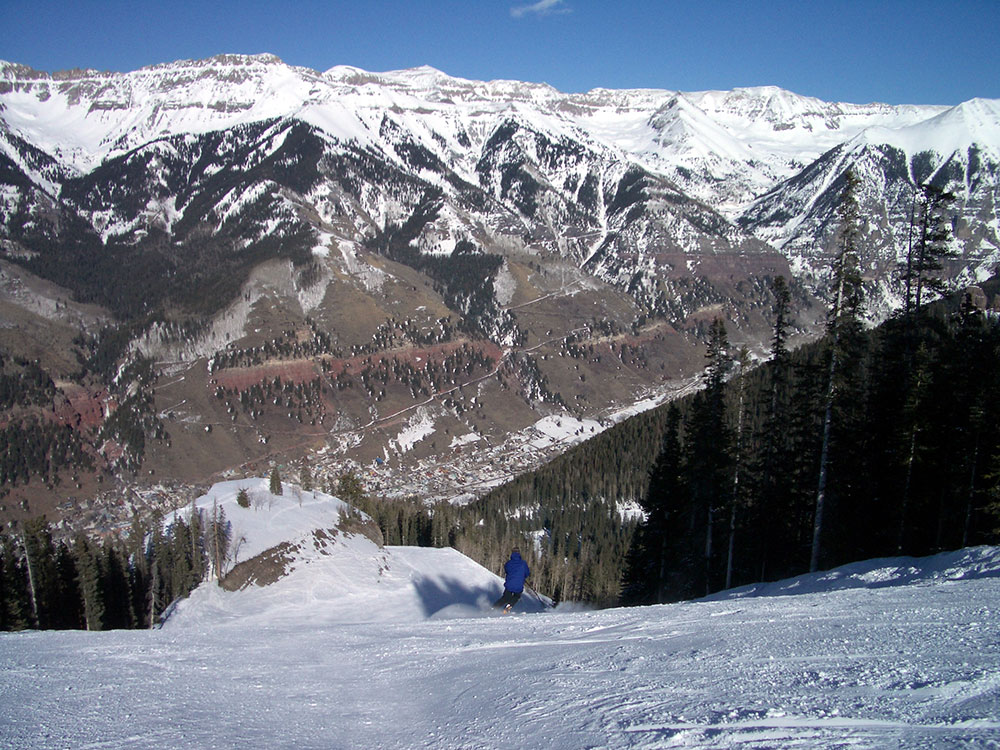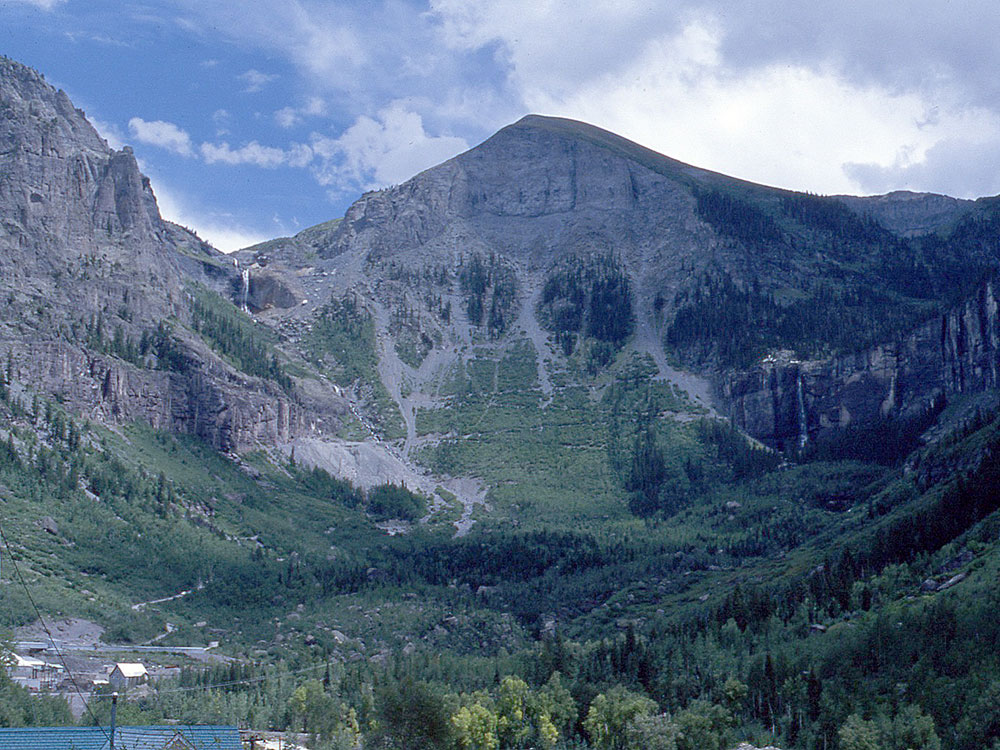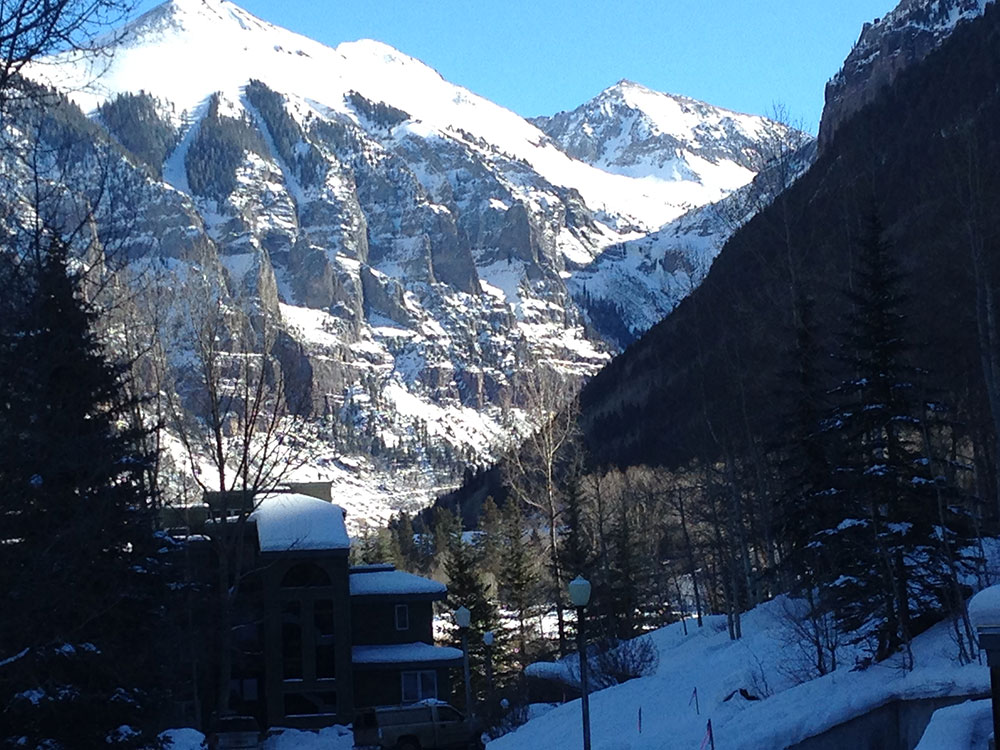Former silver mining camp in the western San Juan Mountains now on National Register of Historic Places known for skiing and tourism
Telluride
Montrose, 65 mi
From Grand Junction (126 mi): Follow I-70BL E and 29 Rd to US-50 E in Orchard Mesa. Continue on US-50 E. Take US-550 S to CO-62 W/State Hwy 62/Sherman St in Ridgway. Follow CO-62 W/State Hwy 62 and CO-145 S to W Colorado Ave in Telluride
From Ouray (50 mi): Head north on US-550 N/3rd St/Main St toward 7th Ave. Turn left onto CO-62 W/State Hwy 62/Sherman St. Turn left onto CO-145 S. At the traffic circle, take the 2nd exit onto W 145 Spur Hwy N. Continue straight onto W 145 Spur Hwy. At the traffic circle, continue straight onto W Colorado Ave.
Overview
Telluride is the most populous town of San Miguel County in the southwestern portion of the state of Colorado. The town is a former silver mining camp on the San Miguel River in the western San Juan Mountains. The first gold mining claim was made in the mountains above Telluride in 1875, and early settlement of what is now Telluride followed. The town itself was founded in 1878 as "Columbia", but due to confusion with a California town of the same name, was renamed Telluride in 1887 for the gold telluride minerals found in other parts of Colorado. These telluride minerals were never found near Telluride, but the area's mines for some years provided zinc, lead, copper, silver, and other gold ores.
The Telluride Historic District, which includes a significant portion of the town, is listed on the National Register of Historic Places and is also one of Colorado's 20 National Historic Landmarks.

History
Gold was first discovered in Colorado near present-day Denver, setting off the Pike's Peak gold rush of 1858. The Smuggler gold vein above Telluride, and placer gold in the San Miguel River, were discovered in 1875. John Fallon made the first claim in Marshal Basin above Telluride in 1875 and early settlement of Telluride followed. The town itself was founded in 1878. Telluride was originally named "Columbia", but due to confusion with Columbia, California, the name was changed by the post office in 1887. The town was named after valuable ore compounds of the chemical element tellurium, a metalloid element which forms natural tellurides, the most notable of which are telluride ores of gold and silver. Although gold telluride minerals were never actually found in the mountains near Telluride, the area's mines were rich in zinc, lead, copper, silver, and ores which contained gold in other forms.
Telluride began slowly because of its isolated location. In 1881, a toll road was opened by Otto Mears which allowed wagons to go where only pack mules could go before. This increased the number of people in Telluride, but it was still expensive to get gold-rich ore out of the valley.
In 1891, the Rio Grande Southern railroad, also begun by Mears, arrived in Telluride, eventually building a two stall engine house, water facilities, a section house and a bunkhouse, sidings and a depot. It continued further up the valley to end its Telluride branch at Pandora, serving the mines and the town until 1952. The cheaper and consistent transportation for passengers and freight allowed miners and goods to flow into the San Miguel town and ore to flow out to the mills and foundries elsewhere. This brought a brief but unprecedented boom to Telluride before the Panic of 1893.
Telluride's most famous historic mines are the Tomboy, Pandora, Smuggler-Union, Nellie, and Sheridan mines. Beginning in 1939, the hard-rock mining operations in the Red Mountain and Telluride mining districts began a lengthy consolidation under the Idarado Mining Company (Idarado), now a division of Newmont Mining. The consolidation ended in 1953 with Idarado's acquisition of the Telluride Mines. Idarado kept the underground workings and mill operations open at Telluride's Pandora hard-rock mine until 1978. When the mine officially closed, the snow which tormented Telluride's miners became the town's new source of income, in the form of skiing and tourism.
Mining was Telluride's only industry until 1972, when the first ski lift was installed by Telluride Ski Resort founder Joseph T. Zoline and his Telluride Ski Corporation (Telco). Zoline bought the land for the future resort in 1969 and began to craft the slopes. Along with his mountain manager, Telluride native Bill "Sr." Mahoney, they slowly and thoughtfully put together a plan for sustained development of Telluride and the region. As mining phased out and a new service industry phased in, the local population changed sharply. Mining families fled Telluride to settle in places like Moab, Utah, where uranium mining offered hope of continued employment.
As the final ore carts were rolling out of the Pandora mine, tourists began to discover Telluride's views, skiing, and autumn color changes. In 1978, Ron Allred and his partner Jim Wells bought a stake of the ski area to form the Telluride Company. They expanded the infrastructure by adding a gondola connecting Telluride with the Mountain Village.
In 1971 the Telluride Council for the Arts and Humanities (TCAH) was founded and organized by Scott Brown, Chris Gertz and Burk Thompson and fellow local arts and crafts people following a sidewalk arts show on Main Street. TCAH also founded over the years a number of festivals which include: The Telluride Film Festival; Telluride Bluegrass Festival; Telluride Mountainfilm Festival; Telluride Tech Festival; Telluride Jazz Festival; Telluride Chamber Music Festival and the Countdown to New Years held in front of the San Miguel County Courthouse to welcome in the New Year at Midnight on Main Street.
Telluride has an elevation of 8,750 feet (2,670 m) in an isolated spot in Southwest Colorado. From the west, Colorado Route 145 is the most common way into Telluride; two other passes enter the town, Imogene Pass and Black Bear Pass.
On the eastern side of town, there are two waterfalls: Ingram Falls, which is visible from town, and Bridal Veil Falls and the Bridal Veil Hydroelectric plant, which are just out of sight from town to the right of Ingram.
Beyond the ski lifts, Telluride is now widely recognized as an all-season resort. Telluride Ski Resort is the main attraction in the winter. During summer, Telluride transforms into an outdoor recreation hot spot, with tourists visiting to enjoy mountain biking, hiking, river rafting, sightseeing and more.
Telluride features over 30 hiking trails ranging in difficulty level. Some of the hiking routes include Ajax Peak, Bear Creek Falls, Hope Lake, and Bridal Veil Falls. Hiking season begins in May and lasts until early October, with waterfalls gushing in June and wildflowers at their peak in early July. The trails range from quick and easy runs to multi-day hiking trips that reach an elevation of 14,000 feet. Nearly all the trails feature waterfalls, wildflowers, and high alpine lakes.
Telluride's free Gondola is the only one of its kind in North America. It stops at three stations: Telluride, San Sophia, and Mountain Village and was the first leg of a transportation agreement for the Telluride Region that was stipulated as part of the Mountain Village zoning expansion that would provide free gondola service from the Town of Telluride and the Mountain Village to the Aldasoro Development, the West Meadows Development, the Valley Floor Development and the West Meadows Development to virtually eliminate the use or need for a car in the Telluride Region of San Miguel County. It is a 13-minute ride and reaches an elevation of 10,540 feet at the San Sophia station. The gondola cabins feature bike and ski racks for recreational use. There are also pet-friendly and handicap accessible cabins available.
This article uses material from the Wikipedia article "Ouray, Colorado", which is released under the Creative Commons Attribution-Share-Alike License 3.0

-1000.jpg)

-1000.jpg)